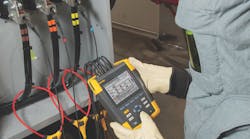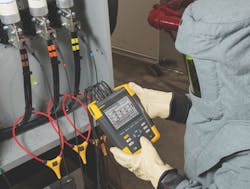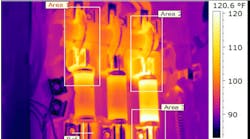On the surface, electrical testing and measurement is all about numbers. It’s a straightforward process of gathering data that, when properly collected and analyzed, reveals essential information about the status and condition of electrical components and systems.
But as much as testing and measurement is a hard and fast science, it also amounts to an art of sorts — a function of the body of knowledge, experience, intuition, and interpretive skills that testing personnel bring to the task. Highly sophisticated test instruments and refined procedures have steadily improved the testing function. But as with any tool, they’re only as good as the operator. Owing to different understanding and interpretation of theory and varying levels of attention to details on the sequence of procedures and adherence to safety protocols, test professionals often put their own mark on the process.
One consequence is that differences of opinion exist with regard to not only what tests to perform, but also on exactly how to conduct them to produce the most accurate and reliable diagnostic results and best overall procedural outcomes. Testing professionals are typically guided by a mix of well-developed standard operating procedures, direct field experience, and an innate sense of how to adapt techniques to different challenges.
But there also may be a surprising degree of consensus in the community. Specifically, about what areas and specific types of testing demand extra attention to procedural detail to ensure not only accurate and reliable results but also a sufficient margin of personal safety.
Nuancing the details
Take the process of testing for insulation resistance using a megohmmeter. The reliability of this test is heavily dependent on the tester knowing what specific type of test to perform and when — accounting for possible variability in readings and understanding the importance of sampling duration.
Randy Barnett, program manager for electrical codes and standards at NTT Training, Centennial, Colo., says inattention to these critical details is still commonplace, producing inaccurate readings on voltage leakage that can result in catastrophic failure. A common mistake in taking spot readings is applying test voltage for mere seconds, far less than the recommended 60 seconds.
“With a minute you can accurately measure current leakage, but what often happens is people grab their meter — and if they have 10 motors to test, say, they just run through them quickly,” he says. “The result is you’ll never know the condition of the insulation because you have inaccuracies and inconsistencies over a series of readings.”
Bob Clukey, technical resource administrator for TPC Trainco, Englewood, Colo., echoes Barnett’s sentiments, noting that many mistakenly think the spot test is sufficient in every situation. This is worrisome, especially given its frequent misuse. Like Barnett, he says two other tests — one measuring dielectric absorption ratio (DAR) and the other polarization index — always have to be considered under specific circumstances.
“Everyone thinks the spot test will tell you all you need to know, but if you have conditions like high moisture level in a facility or high ambient temperatures, it might be important to do these tests,” says Clukey.
Both tests, they say, require the same level of attention to duration. Sixty seconds on up to 10 minutes in some cases is needed for the polarization test, while 30 seconds is needed for the DAR test.
“They take longer to perform and require readings at intervals,” Barnett says. “They’ve been around a long time, but, in my experience, people just don’t know much about them.”
Likewise, familiarity with very low-frequency testing techniques for medium-voltage power cable isn’t as widespread as it should be by now, says Kerry Heid, president and CEO of electrical services provider Shermco Industries-Canada, Regina, Saskatchewan. Heid says very low frequency (VLF) measurements using a Tan Delta diagnostic test are generally recognized as superior to direct current (DC) high-potential (hi-pot) testing for assessing insulation resistance. But even though they tend to degrade cable, DC hi-pot tests are still routine, Heid says.
“I just saw a specification from an engineering company that called for that type of test, even though IEEE is shying away from recommending it,” he says.
The advantage of VLF testing is that it sidesteps the problem of leaving a charge in an insulation void, a problem unique to DC hi-pot tests that Heid says can lead to cable failure, even though the cable may pass the test.
“Rather than leaving that stored charge, VLF discharges the voltage and produces a non-destructive test,” he says. “Most NETA-certified companies have gone to VLF testing, but there are some companies not aware of the latest standards, or they may be reluctant to make the investment needed to do it.”
Heid also points to partial discharge (PD) testing as a practice that, while becoming more widespread, remains a debated one in terms of how it’s best performed. Understood as a good way to get early warning of high-frequency energy release and subsequent short-circuiting and arcing, PD tests have been growing more accurate and reliable, says Heid. But there’s still debate on what techniques produce the best results.
“Even experts have their own opinions as to how to do this type of testing, and it’s still debated at NETA conferences,” he says. “If it’s done when the equipment is energized, you need specialized equipment because harmonics and noise can fool you in terms of what you’re looking for. At Shermco, we like to use a source similar to VLF as well as online ultrasonic testing. But there are a variety of techniques.”
(to see a PDF of Recommended Electrical Equipment Maintenance Tasks and Intervals, click here)
New problems, new tests
The emergence of new electrical system dysfunctions traceable to both new and increased demands for power also is placing a premium on proper test selection and performance.
A prime example, says Clukey, is harmonics. The steady proliferation of electronics within facilities has caused loads and pulse modulation problems to increase, leading to an expanding problem of harmonic distortions feeding back into the electrical distribution system. Symptoms such as variable frequency drive (VFD) tripping, flickering lights, and computer monitors going black are indicative of problems that can lead to overheated neutral wires and issues with transformers.
Remedies are available, Clukey says, but identifying and quantifying the problem is the first step. Power loggers have emerged as the best way to test, he says, but they’re still not fully embraced.
“Some still try to test with a voltage [meter] or ohmmeter, but they’re not going to give you an accurate reading,” says Clukey. “Deploying a power logger right at the service, on the load side of the switchgear, and leaving it there for a week or even up to a month will let you see what’s happening in that distribution system. There are many different kinds out there, but they’ll all give you an accurate picture.”
Like Clukey, Barnett also sees some gaps in recognizing the deficiencies and limitations of some traditional testing tools. An example is the digital multimeter (DMM) and the comparative inadequacy of standard average-responder type meters. Since such meters only read pure sinewaves, they’re handicapped in detecting distorted non-sinusoidal waveforms that are more prevalent in modern electrical systems. The better option, he says, is a true-rms device designed to more accurately read values in systems where those waveforms are present.
“A lot of techs don’t understand the difference between the meters, but I think that given all the electronics we have in systems today, we should be using the true-rms meter, especially when troubleshooting VFDs, UPS systems, battery chargers, and the like,” says Clukey.
Other testing tools have grown so sophisticated over time that they’re either not deployed or not used properly or effectively. Barnett points to power quality analyzers as an example. In the right hands, he says, they’re an essential tool for troubleshooting the complexities of modern electrical systems plagued with harmonics, voltage dips, swells and sags, voltage transients and the like. Far too often, though, they’re gathering dust because testers lack competency in operating them and interpreting the results.
“We go into places that have them, but this $10,000 piece of equipment is sitting on the shelf because no one knows how to use it,” he says. “They could be put to good use, but the company invests in the equipment and not the training.”
Assessing power quality with testing equipment requires nuanced understanding of how to take measurements and do so safely, understand the results, and take corrective action. That’s knowledge that comes from a solid grounding in the theoretical aspects of power characteristics and a good grasp of the testing procedure.
“Both the voltage and current leads need to be properly connected, and even the current clamps need to face in the proper direction,” Barnett says. “If there’s overheating on neutral wires, you need to look for certain harmonic values; if there’s a misoperation of PLCs, you need to look at voltage values.”
Testing safely
While there can be wiggle room in how tests are conducted and interpreted to yield the most accurate results, there’s less perhaps when it comes to how to test safely. Detailed procedures laid out in comprehensive workplace electrical safety standards like NFPA 70E, “Standard for Electrical Safety in the Workplace,” exist to ensure that worker safety is prioritized, and to emphasize the importance of adhering to the letter, and not just the spirit of the “laws” of safety.
But some electrical testing professionals say there’s still much room for improvement in how testing personnel approach the safety question. Too many testers, some say, find themselves in situations where corners are cut due to ignorance, expedience, or both. And the consequences can extend beyond safety — to include the integrity of the tests themselves.
Robert LeRoy, CEO of LeRoy Electrical Enterprizes, Inc., a Lakeland, Fla., maintenance services company, says to varying degrees the testing function still suffers from inattention to detail. Testers are frequently deployed without what he calls his own definition of “PPE”: planning, preparation, and a focus on execution.
A frequent consequence, one with clear safety ramifications, is selecting the wrong category of multimeter for the job, he says.
“Testers have to understand the risks of transient voltage spikes and the need to protect themselves with meters rated for the proximity of their work to the power source,” LeRoy says. “Most meters will be rated CAT III or CAT IV or be dual rated, for a higher margin of safety with riskier work, and you can’t use a lower-rated meter in a higher category risk area.”
But even with the right meter for the job, testers must be vigilant in routinely inspecting and calibrating meters. Over time and through misuse, meters can lose their ability to deliver accurate readings, jeopardizing the testing process and personnel safety.
“Knowing how to verify that metering and testing equipment will function the way it should is key,” says LeRoy. “Often, electrical workers don’t store their meters properly, they end up being stored with leads wrapped around the device, and that stresses the connections. A big error gap is not really knowing meters and how to validate that they’re working correctly.”
Jeff Grovom, a lead electrical instructor with NTT Training, Centennial, Colo., advocates annual inspection and calibration of meters, especially those used to check for voltage. In reality, though, practices are all over the map.
“I’ve been to companies in the mining industry that haven’t sent their meters out in 10 years, and others that calibrate them annually and put stamps on them to verify it,” he says.
A critical multimeter check that can be easy to overlook, Grovom says, is the “live-dead-live” test, a three-step process of confirming a meter’s reliability in indicating an absence of voltage prior to de-energized work. While it can be accomplished in an environment with a known voltage source, in situations where one is not present, the test can also be conducted using a special battery-powered proving unit.
“When the power is shut off and there’s nothing to verify that the meter is working, proving units in the vicinity of where the work is being done are essential,” Grovom says.
Indeed, worker safety has grown to become perhaps the dominant concern and focal point of electrical testing education and training. But while safety is paramount, some observers see a concerted move to disseminating more knowledge about test and measurement techniques and best practices out to the field — where interest in the finer points of maintenance, operational reliability and efficient performance may be growing. As that future unfolds, there will be a growing premium on developing greater consensus and agreement on the best and most efficient methods of testing.
“I think we’re heading in the right direction,” says Barnett, a 40-year veteran in the electrical testing field. “It comes down to a training issue, and while we’ve seen a big push on testing safety, the next area we’ll see growth in is maintenance. We’ll all have to be better trained in that area, and testing will be part of that.”
Zind is a freelance writer based in Lee’s Summit, Mo. He can be reached at [email protected].
SIDEBAR: Testing, Maintenance More Strongly Linked to Worker Safety
Thorough and competent electrical testing procedures seem to be even more critical in the wake of recent revisions to NFPA standards for worker electrical safety.
New wording in the 2015 edition of NFPA 70E, “Standard for Electrical Safety in the Workplace,” effectively reiterates that more procedurally correct testing of equipment and ongoing documentation of results is a route to an improved margin of safety for workers.
Among the revisions: Persons deemed qualified to maintain electrical equipment must be trained and familiar with very specific maintenance and testing procedures; inspection and testing of overcurrent protective devices must conform to manufacturer specifications or consensus industry maintenance/testing standards like ANSI/NETA, IEEE 3007.2, and NFPA 70B, “Recommended Practice for Electrical Equipment Maintenance;” results of tests and maintenance must be documented and maintained; and that maintenance responsibility now lies specifically with equipment owners.
The increased focus in NFPA 70E on equipment maintenance, and by extension testing, indicates there’s greater recognition of a strong link between worker safety and properly maintained and tested electrical equipment, according to some workplace electrical maintenance/safety professionals.
Robert LeRoy, owner of LeRoy Electrical Enterprizes, Inc., Lakeland, Fla., says the 70E revisions will likely end up creating more needed awareness of NFPA 70B. Revised for 2016, it’s a comprehensive guide to all aspects of preventive maintenance that dedicates a lot of ink to the particulars of routine testing — a subject he suspects has been historically overshadowed by an emphasis on how to respond to fully formed problems.
“I think most electrical workers in those environments are just beginning to realize that 70B even exists, and that’s a major gap,” LeRoy says. “Many of the tests they’re most familiar with are strictly oriented to troubleshooting to determine why something’s broken. With 70B we’re talking about tests that can be done to recommend repair and replacement, which can also be economical for equipment owners.”
With the onus now more squarely on owners of equipment to keep tabs on its condition to better ensure worker safety, LeRoy says it’s likely companies and their maintenance providers will turn more to 70B for guidance. By closely adhering to recommendations on the specific type and frequency of tests, employers will better ensure the safety of workers and the success of three classes of maintenance programs: preventive, predictive, and reliability centered.
“A good half of NFPA 70B is devoted to recommended tests — ones that will help equipment owners determine how often they need to look at it and what they need to look at,” he says.
Jeff Grovom, senior lead electrical instructor with NTT Training, Centennial, Colo., is also encouraged by the tighter link between 70E and 70B. With closer attention to electrical equipment condition testing, owners will be more focused on establishing and documenting conditions from the time of installation. That will better ensure that workers know the condition and repair history of equipment, arming them with more knowledge before they approach it for repairs, testing, and troubleshooting.
“With a focus on 70B, we’ll be able to get a good baseline on switchgear and other equipment, allowing us to be proactive rather than reactive because we’ll be able to predict when something might fail,” he says.





